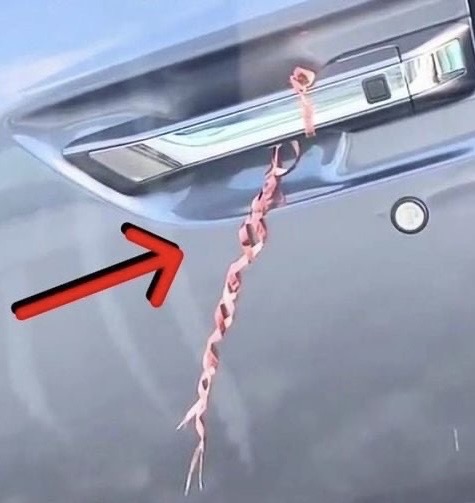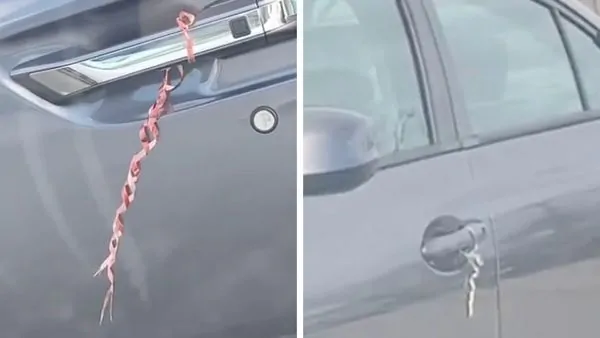
Lately, the internet has been buzzing with alarming reports about mysterious markings appearing outside women’s homes and strange water bottles placed on cars. Many viral videos suggest that these could be tactics used by human traffickers and kidnappers to target women. One particular theory claims that the code “1F” stands for “one female” and that a water bottle is placed on a car to lure a woman into a vulnerable situation. But how much of this is true? Let’s take a closer look.
The Viral Warning About Wires on Car Handles
One of the most widely shared videos shows a woman recording a car in a parking lot with a wire attached to its door handle. The video caption reads, “WTF is this a joke?” followed by an urgent plea to prevent abductions. Moments later, she reveals another car in the same parking lot with a similar wire wrapped around its handle.
This sparked widespread concern, with many believing it to be a sinister strategy used by traffickers. In response to these frightening claims, a man posted a TikTok video explaining that zip ties, wires, or threads attached to car doors are an old trick used by criminals. According to him, the wire makes it difficult for someone to quickly open their car door, giving attackers more time to strike.
The Origins of the “Wire Trick” and What Experts Say
Despite the panic these videos have caused, it’s important to examine the facts. The “wire trick” first gained attention through a Facebook post in 2015. This post suggested that traffickers were using this method to distract potential victims. However, Canadian law enforcement, where the original post surfaced, investigated the claim and found no evidence that the tactic had led to any actual abductions.
Moreover, organizations dedicated to combating human trafficking have not identified the “wire trick” as a widespread method. Experts stress that while human trafficking is a serious crime, the majority of victims are not abducted in parking lots by strangers. Instead, traffickers often manipulate individuals they already know and recruit victims through social media or other online platforms.
Dr. Celia Williamson, director of the Human Trafficking and Social Justice Institute at the University of Toledo, has dismissed these social media warnings as “ridiculous.” She argues that they spread unnecessary fear and function more as urban legends than genuine threats. Law enforcement agencies also emphasize that human traffickers rarely target random individuals in public places.

Why These Warnings Go Viral
The spread of alarming social media posts about potential threats is nothing new. People tend to share them out of concern for their safety and that of their loved ones. While it’s good to be cautious, these viral warnings can sometimes cause unnecessary panic and misinformation.
There are a few reasons why these stories gain traction:
- Fear and Emotion: People react strongly to fear-based content, making them more likely to share it.
- Lack of Fact-Checking: Many social media users don’t verify information before reposting.
- The Power of Visuals: Videos showing wires, zip ties, or markings on cars make the claims seem more credible, even without evidence.
How to Stay Safe Without Falling for Misinformation
While it’s always smart to be aware of your surroundings, it’s just as important to rely on facts rather than fear. Here’s what you can do to stay safe while avoiding unnecessary panic:
- Stay Alert – Whether you’re walking to your car at night or in a new environment, always be mindful of your surroundings.
- Verify Information – Before sharing a warning online, check with reliable sources like law enforcement agencies or reputable news outlets.
- Lock Your Car Immediately – If you’re concerned about safety, make it a habit to lock your car as soon as you get inside.
- Trust Your Instincts – If something feels off, don’t ignore it. Call for help or alert security personnel if needed.
- Educate Yourself About Real Threats – Instead of focusing on viral myths, learn about actual human trafficking tactics and how traffickers operate online.
The Bigger Picture: Human Trafficking Is a Real Issue, But Not Like This
Human trafficking is a critical problem, but it’s rarely as simple as a wire on a car handle or a water bottle on a hood. In reality, traffickers rely on manipulation, coercion, and exploitation rather than dramatic abduction schemes. Many victims are lured in by false job offers, fake relationships, or threats against their families.
Instead of spreading fear-driven misinformation, it’s far more effective to support organizations that actively combat human trafficking. Groups like Polaris, the National Human Trafficking Hotline, and local advocacy organizations provide resources to help victims and prevent trafficking.
Final Thoughts: Stay Aware, But Don’t Panic
It’s always wise to stay cautious and be aware of your surroundings, but not every internet warning is accurate. While social media has the power to spread valuable safety tips, it can also amplify myths that create unnecessary fear. The best way to protect yourself and others is to stay informed, fact-check before sharing, and focus on real solutions rather than viral hoaxes.
By working together, we can foster a safer and more informed community—one that prioritizes real threats over urban legends. If you ever feel unsafe, trust your instincts and reach out to the proper authorities. Awareness is key, but so is keeping fear in check.





